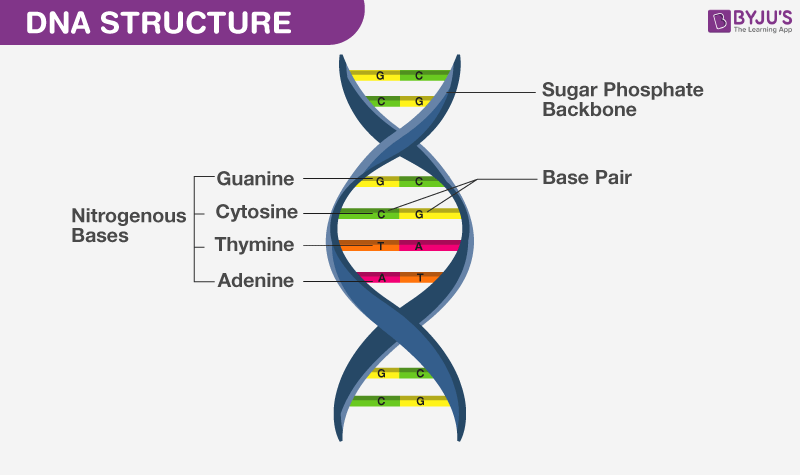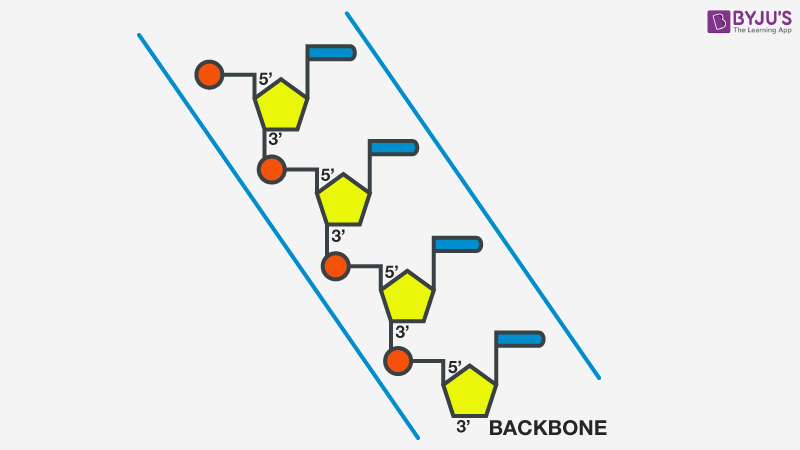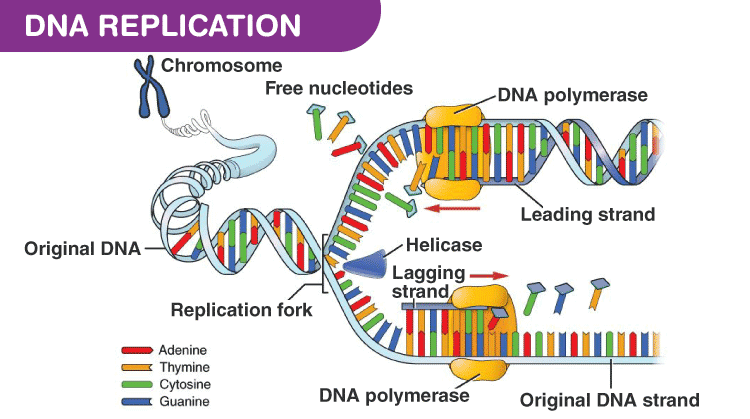Chapter 6 Answers Continued How Dna Works Worksheet
Nucleic acids are the organic materials present in all organisms in the form of DNA or RNA. These nucleic acids are formed by the combination of nitrogenous bases, sugar molecules and phosphate groups that are linked by different bonds in a series of sequences. The DNA structure defines the basic genetic makeup of our body. In fact, it defines the genetic makeup of nearly all life on earth.
Table of Contents
- What is DNA?
- Discovery
- Diagram
- DNA Structure
- Chargaff's Rule
- DNA Replication
- Function of DNA
- Why DNA is called a Polynucleotide Molecule?
Read on to explore DNA meaning, structure, function, DNA discovery and diagram in complete detail.
What is DNA?
"DNA is a group of molecules that is responsible for carrying and transmitting the hereditary materials or the genetic instructions from parents to offsprings."
This is also true for viruses, as most of these entities have either RNA or DNA as their genetic material. For instance, some viruses may have RNA as their genetic material, while others have DNA as the genetic material. The Human Immunodeficiency Virus (HIV) contains RNA, which is then converted into DNA after attaching itself to the host cell.
Apart from being responsible for the inheritance of genetic information in all living beings, DNA also plays a crucial role in the production of proteins. Nuclear DNA is the DNA contained within the nucleus of every cell in a eukaryotic organism. It codes for the majority of the organism's genomes while the mitochondrial DNA and plastid DNA handles the rest.
The DNA present in the mitochondria of the cell is termed mitochondrial DNA. It is inherited from the mother to the child. In humans, there are approximately 16,000 base pairs of mitochondrial DNA. Similarly, plastids have their own DNA, and they play an essential role in photosynthesis.
Also Read:Difference between gene and DNA
Full-Form of DNA
DNA is known as Deoxyribonucleic Acid. Itis an organic compound that has a unique molecular structure. It is found in all prokaryotic cells and eukaryotic cells.
DNA Types
There are three different DNA types:
- A-DNA:It is a right-handed double helix similar to the B-DNA form. Dehydrated DNA takes an A form that protects the DNA during extreme conditions such as desiccation. Protein binding also removes the solvent from DNA, and the DNA takes an A form.
- B-DNA:This is the most common DNA conformation and is a right-handed helix. The majority of DNA has a B type conformation under normal physiological conditions.
- Z-DNA:Z-DNA is a left-handed DNA where the double helix winds to the left in a zig-zag pattern. It was discovered by Andres Wang and Alexander Rich. It is found ahead of the start site of a gene and hence, is believed to play some role in gene regulation.
Who Discovered DNA?
DNA was first recognized and identified by the Swiss biologist Johannes Friedrich Miescher in 1869 during his research on white blood cells.
The double helix structure of a DNA molecule was later discovered through the experimental data by James Watson and Francis Crick. Finally, it was proved that DNA is responsible for storing genetic information in living organisms.
Also Read:Difference between deoxyribose and ribose
DNA Diagram
The following diagram explains the DNA structure representing the different parts of the DNA. DNA comprises a sugar-phosphate backbone and the nucleotide bases (guanine, cytosine, adenine and thymine).

DNA Diagram representing the DNA Structure
Read more: Properties of DNA
DNA Structure
The DNA structure can be thought of as a twisted ladder. This structure is described as a double-helix, as illustrated in the figure above. It is a nucleic acid, and all nucleic acids are made up of nucleotides. The DNA molecule is composed of units called nucleotides, and each nucleotide is composed of three different components such as sugar, phosphate groups and nitrogen bases.
The basic building blocks of DNA are nucleotides, which are composed of a sugar group, a phosphate group, and a nitrogen base. The sugar and phosphate groups link the nucleotides together to form each strand of DNA. Adenine (A), Thymine (T), Guanine (G) and Cytosine (C) are four types of nitrogen bases.
These 4 Nitrogenous bases pair together in the following way: A withT, and C with G. These base pairs are essential for the DNA's double helix structure, which resembles a twisted ladder.
The order of the nitrogenous bases determines the genetic code or the DNA's instructions.

Components of DNA Structure
Among the three components of DNA structure, sugar is the one which forms the backbone of the DNA molecule. It is also called deoxyribose. The nitrogenous bases of the opposite strands form hydrogen bonds, forming a ladder-like structure.

DNA Structure Backbone
The DNA molecule consists of 4 nitrogen bases, namely adenine (A), thymine (T), cytosine (C) and Guanine (G), which ultimately form the structure of a nucleotide. The A and G are purines, and the C and T are pyrimidines.
The two strands of DNA run in opposite directions. These strands are held together by the hydrogen bond that is present between the two complementary bases. The strands are helically twisted, where each strand forms a right-handed coil, and ten nucleotides make up a single turn.
The pitch of each helix is 3.4 nm. Hence, the distance between two consecutive base pairs (i.e., hydrogen-bonded bases of the opposite strands) is 0.34 nm.

The DNA coils up, forming chromosomes, and each chromosome has a single molecule of DNA in it. Overall, human beings have around twenty-three pairs of chromosomes in the nucleus of cells. DNA also plays an essential role in the process of cell division.
Also Read: DNA Packaging
Recommended Video:

Chargaff's Rule
Erwin Chargaff, a biochemist, discovered that the number of nitrogenous bases in the DNA was present in equal quantities. The amount of A is equal to T, whereas the amount of C is equal to G.
A=T; C=G
In other words, the DNA of any cell from any organism should have a 1:1 ratio of purine and pyrimidine bases.
DNA Replication
DNA replication is an important process that occurs during cell division. It is also known as semi-conservative replication, during which DNA makes a copy of itself.

DNA replication takes place in three stages:
Step 1: Initiation
The replication of DNA begins at a point known as the origin of replication. The two DNA strands are separated by the DNA helicase. This forms the replication fork.
Step 2: Elongation
DNA polymerase III reads the nucleotides on the template strand and makes a new strand by adding complementary nucleotides one after the other. For eg., if it reads an Adenine on the template strand, it will add a Thymine on the complementary strand.
While adding nucleotides to the lagging strand, gaps are formed between the strands. These gaps are known as Okazaki fragments. These gaps or nicks are sealed by ligase.
Step 3: Termination
The termination sequence present opposite to the origin of replication terminates the replication process. The TUS protein (terminus utilization substance) binds to terminator sequence and halts DNA polymerase movement. It induces termination.
Also Read:DNA Replication
DNA Function
DNA is the genetic material which carries all the hereditary information. Genes are the small segments of DNA, consisting mostly of 250 – 2 million base pairs. A gene code for a polypeptide molecule, where three nitrogenous bases sequence stands for one amino acid.
Polypeptide chains are further folded in secondary, tertiary and quaternary structures to form different proteins. As every organism contains many genes in its DNA, different types of proteins can be formed. Proteins are the main functional and structural molecules in most organisms. Apart from storing genetic information, DNA is involved in:
- Replication process: Transferring the genetic information from one cell to its daughters and from one generation to the next and equal distribution of DNA during the cell division
- Mutations: The changes which occur in the DNA sequences
- Transcription
- Cellular Metabolism
- DNA Fingerprinting
- Gene Therapy
Also Read:r-factor
Why DNA is called a Polynucleotide Molecule?
The DNA is called a polynucleotide because the DNA molecule is composed of nucleotides – deoxyadenylate (A) deoxyguanylate (G) deoxycytidylate (C) and deoxythymidylate (T), which are combined to create long chains called a polynucleotide. As per the DNA structure, the DNA consists of two chains of polynucleotides.
Also Read:Genetic Material
For more detailed information on DNA meaning, diagram, its types, DNA structure and function, or any other related topics, explore at BYJU'S Biology.
Explore more
- Difference between Replication and Transcription
- DNA Cloning
- DNA Fingerprinting
- DNA As Genetic Material
- DNA Structure and Polynucleotide
- How is DNA inherited from each parent?
- Do you get more DNA from your mother or father?
Frequently Asked Questions
What is the structure of DNA?
DNA is a double helical structure composed of nucleotides. The two helices are joined together by hydrogen bonds. The DNA also bears a sugar-phosphate backbone.
What are the three different types of DNA?
The three different types of DNA include:
- A-DNA
- B-DNA
- Z-DNA
How is Z-DNA different from other forms of DNA?
Z-DNA is a left-handed double helix. The helix winds to the left in a zig-zag manner. On the contrary, A and B-DNA are right-handed DNA.
What are the functions of DNA?
The functions of DNA include:
- Replication
- Gene expression
- Mutation
- Transcription
- Translation
What type of DNA is found in humans?
B-DNA is found in humans. It is a right-handed double-helical structure.
Source: https://byjus.com/biology/dna-structure/
0 Response to "Chapter 6 Answers Continued How Dna Works Worksheet"
Post a Comment